#t crb
Text
my mom told me about the potential of t crb (t coronae borealis) going nova and i am SO EXCITED!!!!!
i love space so much and the fact that i could possibly see a nova eruption makes me SO UNBELIEVABLY HAPPY!!!! THIS IS A ONCE IN A LIFETIME MOMENT AND I MAY GET TO SEE IT
i'm not sure how to properly explain it cus i don't understand all the science talk from my sources, but apparently this star system has recurrent novas (get more accurate and well explained info from nasa's official site and t crb's wiki page, i suggest also reading up on recurrent novas which you can find on said wiki) which means it has nova eruptions more then once, the last time being in 1946
the reason for this is becus it contains a red giant and white dwarf and the red giant is feeding material to the white dwarf (which i believe is what causes it to be a recurrent nova??)
if i understand what i'm reading, t crb goes nova, not supernova, meaning that only the atmosphere explodes
but the point is this only ever happens possibly every 80 years and could happen anywhere from this month to september 2024. i could get to see a nova explosion for my BIRTHDAY
if you want to keep an eye on it yourself, t crb is in the coronae borealis constellation, between the constellations hercules and bootes
#space#spaceblr#t crb#t coronae borealis#nova#stars#SPACE EXPLOSIONS FOR MY BIRTHDAY PLS#text post#happy chatter
0 notes
Text
anyone else hyped for the probably upcoming eruption of T coronae borealis (T CrB) the recurring nova in the constellation corona borealis
180 notes
·
View notes
Photo

2024 April 30
GK Per: Nova and Planetary Nebula
Image Credit & Copyright: Deep Sky Collective
Explanation: The star system GK Per is known to be associated with only two of the three nebulas pictured. At 1500 light years distant, Nova Persei 1901 (GK Persei) was the second closest nova yet recorded. At the very center is a white dwarf star, the surviving core of a former Sun-like star. It is surrounded by the circular Firework nebula, gas that was ejected by a thermonuclear explosion on the white dwarf's surface -- a nova -- as recorded in 1901. The red glowing gas surrounding the Firework nebula is the atmosphere that used to surround the central star. This gas was expelled before the nova and appears as a diffuse planetary nebula. The faint gray gas running across is interstellar cirrus that seems to be just passing through coincidently. In 1901, GK Per's nova became brighter than Betelgeuse. Similarly, star system T CrB is expected to erupt in a nova later this year, but we don't know exactly when nor how bright it will become.
∞ Source: apod.nasa.gov/apod/ap240430.html
101 notes
·
View notes
Text
Nova Explosion this Year!

A star system, located 3,000 light-years away from Earth, is predicted to become visible to the unaided eye soon. This could be a once-in-a-lifetime viewing opportunity as the nova outburst only occurs about every 80 years. T Coronae Borealis, or T CrB, last exploded in 1946 and astronomers believe it will do so again between February and September 2024.
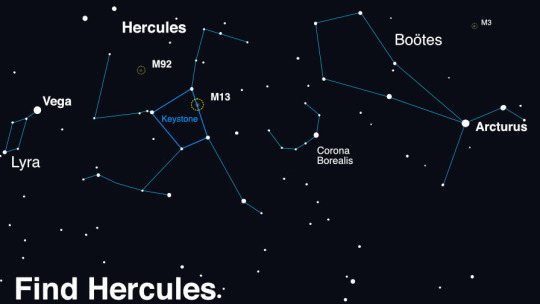
103 notes
·
View notes
Text
A star is about to explode

The Blaze Star is about to go nova in the Northern Crown. For a day, this faint star will become as bright as the North Star. In the past, a new star appearing in the sky was a major omen and people would pay close attention to it, but people rarely understood that it could be a recurrent phenomenon.
Recurrent nova explosions basically happen when a star experiences a large explosion that is nonetheless not big enough to destroy it. In the case of the Blaze Star what happens is that a small white dwarf is orbiting close to a much bigger red giant star. The red dwarf has an “accretion disk” of chemicals around it and as the Blaze Star travels through it it takes in more and more glasses until this reaches critical mass and explodes. Then, for a day, the star becomes 1500 times brighter than it usually is. We know of ten recurrent novae but the Blazing Star has one of the longest known periods between recurrences - about 80 years.
The Blaze Star, also known as T Coronae Borealis (or T Crb) is currently at 18°22 Scorpio and it’s moving slowly through the Scorpio. The last time it lit up was 9 February 1946 when it was at 17°16, then before that it was at 16°10 on 12 May 1866. There’s also two documents that discuss the nova before it was properly discovered. It was observed in around 1787/8 and a medieval manuscript mentions the nova in mid Autumn of 1217 when it was at around 7°04. The Ursperger Chronicle reports it like this:
"In the autumn season of the same year, in the early evening, a wonderful sign was seen in a certain star in the west. This star was located a little west of south, in what astrologers call Ariadne's Crown. As we ourselves observed, it was originally a faint star that for a time shone with great light, and then returned to its original faintness. There was also a very bright ray reaching up the sky, like a large tall beam. This was seen for many days that autumn. The preachers also in these times asserted that many other signs had taken place in heaven and on Earth, which it would be too long to enumerate and to add to this brief account."
I share the full text here because I think as astrologers what it shows us is that ancient astrologers took events like novae seriously and if we are seriously making a case for following in their footsteps we need to do the same. But also, they didn’t understand what they were looking at. We are aware of ten recurrent novae in this galaxy and we didn’t have evidence of this phenomenon at all until the 1900s. Most people who saw a recurrent nova before that thought it was a possibly miraculous one off event. I am 100% expecting to find ancient mesopotamian, Chinese, or Indian records that show that someone somewhere noted a recurrence in ancient times. The ancients were so often able to see more and connect more than we give them credit for. But I’ve not yet seen any evidence of this. For now, we have to assume that the recurrence of nova explosions is something nobody understood until modern times.
The Northern Crown
The Coronae Borealis constellation is named after the garland Venus gave to Ariadne when she married Dionysus. It therefore traditionally has some Venus-Mercury themes. In some cases this seems to play out with a connection between the nova event and children. For instance Spiro Agnew had his Sun conjunct the Blazing Star and his wife’s pregnancy at the time of the novae encouraged him to go back to law school.
In some cases it can also relate to adult experiences of children and succession - for instance the month of the nova architect Frank Lloyd Wright’s son sent him a copy of his book about their relationship. It had the very Saturnian title: My Father Who Is On Earth. Frank was not happy and wrote notes throughout the book, his son responded to his comments. The book was published with the full disagreement available for everyone to read. This is all very Saturn-Venus to me - succession, children, creation, difficulty, and legacy all wrapped up in one story.
Passing the Torch from Conflict to Conflict
The most notable event at the last nova was the Soviet prosecutor giving his opening statement at the Nuremberg trials. A couple of Nazis had key signs on those strongly conjunct the Blazing Star - Wilhelm Frick (the architect of Germany’s anti-Jewish laws) and Alfred Rosenberg (the administrator in charge of occupied Russia). Oddly Frick was one of only two Nazis to refuse to testify in his own defense, and Rosenberg was the only Nazi executed following his trial who refused to give a last statement before being hanged. I don’t know what this is about but Hess, the other Nazi who refused to testify had the Blazing Star strongly trine is ascendent. Maybe the influence of the Blazing Star encouraged them to let their lives end with the mercy that we didn’t have to hear them whine about it. Because honestly, nothing of value was lost when the leaders of the WW2 Nazi Party were executed.
Passing the torch from one conflict to another seems kind of key to this nova. On the day of the nova Stalin gave his first major post war speech and said that another war was inevitable because of the "capitalist development of the world economy", and that the USSR would need to concentrate on national defense in advance of a war with the Western nations. This is considered by some to be the start of the Cold War. Meanwhile in Britain, Jewish ex-servicemen beat up a group of fascists who were trying to rebuild their movement - this was both a reflection on the war that had just gone and inspired the formation of the 43 group of anti-fascists which was an essential part of the post war anti-fascist movement. One conflict ends, but immediately, another one starts.
What I’m looking out for
We can expect the nova in the next six months so I’m keeping my eye out for conflicts that are ending and sparking an immediate new conflict. The change over from Israel invading Gaza to a more sustained occupation as part of their ongoing genocide against the Palestinians strikes me as a key one to watch for. The Blazing Star is loosely conjunct Ukraine’s MC and Pluto and its at a sensitive part of various Russian natal charts so this is a conflict to watch when the Blazing Star goes up.
Prince Harry is a key celebrity in this - he has the Blazing Star conjunct his MC and it’s interesting that we’re currently in a period where for the first time ever the British press has more complaints about Prince William’s wife than Meghan Markle. The monarchy is less of a joke than we make it out to be sometimes - the ongoing conflict between the Windsor siblings and their wives demonstrates major faultlines in British society on issues like how tolerant we are of secrecy within the executive arm of government, and how a lot of people understand race and racism. A shift in this conversation could be important.
Of course, with the conception connection some of the most important events of the transit might not become apparent right away. It could be conception, or women finding out they’re pregnant, or starting to tell people. The key thing seems to be how the arrival of a child impacts the parent and this is a really personal thing we might not be aware of unless this hits your personal chart at the right time in the right way.
In general, I’ll simply be watching out for a new star in the sky. Astrology isn’t just about fortune telling, it’s about forming a personal connection to the universe and watching an event like this is one way to do that. I also think astrology is about forming a link to the past. We do this by following the cycles of planets, or in this case, stellar explosions. We also do this by understanding our ancestors who also tried to understand the stars. We have an opportunity to understand the cyclical nature of an event that most past astrologers could only understand as miraculous. I think that’s really beautiful.
Underneath, for the nerds, I have the charts for the three known nova explosions so far:


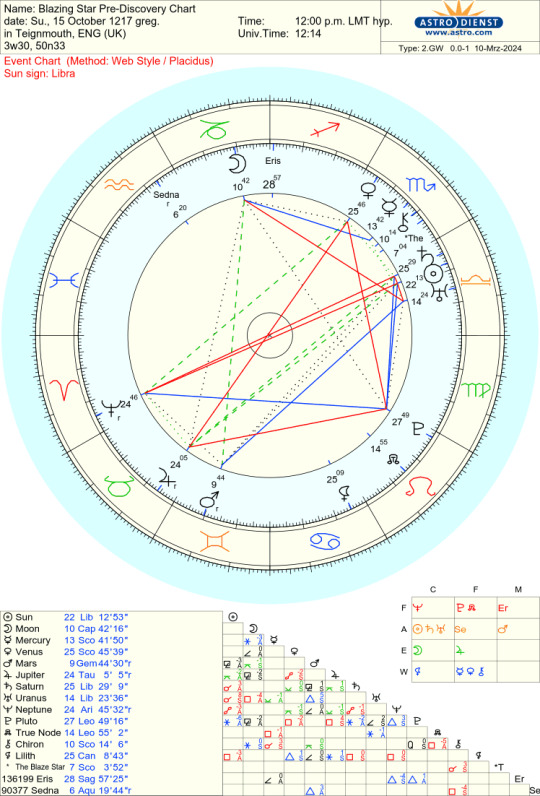
8 notes
·
View notes
Text
The Corona Borealis is home to a white dwarf star named T Coronae Borealis. It is in a binary star system with a red giant type star.
As the red giant in T CrB's system ejects matter, T CrB's gravity attracts or collects it and puts it on its own surface, doing so for years and years, until it reaches its limit.
REFERENCE LINKS IN THE ARTICLE
4 notes
·
View notes
Text

Astrophysicist explains science behind once-in-a-lifetime nova outburst that will light up the sky this year
The total solar eclipse isn't the only reason to keep your eyes to the sky this year. For the first time in 80 years, a star system 3,000 light years away will be visible to the naked eye thanks to a once-in-a-lifetime nova outburst.
NASA announced that the nova, which will create a "new" star in the night sky, will light up the night sky some time between now and September and be as bright as the North Star. One of only five recurring novae in our galaxy, it will be visible for a week before it fades back down.
Jonathan Blazek, an assistant professor of physics at Northeastern University, says this is an exciting moment for amateur astronomers and astrophysicists alike. It's not technically a new star, just a star that is now bright enough for people to see more clearly, Blazek says, but it provides an opportunity to see and understand the cosmos in a new way.
What exactly is a nova?
"There's a broad class of these sorts of events, and they typically share the trait of having two objects, or sometimes more than two objects, close to each other, and you're transferring mass from one to the other," Blazek says. "Eventually, you build up enough mass on usually the hotter object that it ignites, in this case undergoing fusion, and then suddenly you get a very rapid release of energy so it gets much, much brighter."
The star system in question is T Coronae Borealis, or T CrB, and it contains a white dwarf and red giant, two stars that create the perfect conditions for a nova outburst.
A red giant is what happens when a star, like our sun, runs out of fuel and becomes larger and cooler, turning red instead of the white or yellow of a hot star. A white dwarf is what a red giant turns into when it runs out of even more fuel: a very compact star.
What happens when these two stars co-orbit one another is that the white dwarf steadily strips away the atmosphere of the expanding red giant.
"The white dwarf is much smaller and much more compact, so you build up a little disk of mostly hydrogen and maybe some helium as well sitting on the white dwarf," Blazek says. "Eventually enough of it builds up and basically ignites. It's not literally burning in the sense of fire; it's thermonuclear burn and you have hydrogen undergoing a fusion reaction."
As it undergoes that runaway thermonuclear reaction, the white dwarf gets hotter, bigger and brighter, making it easier for us to see it back on Earth. This entire process is part of the natural lifecycle of these stars and why they happen every 80 years. After a white dwarf like this goes nova, it goes back to stripping gas away from the red giant, building up gas at the same rate before eventually another outburst occurs.
Outside of the novelty of these novae,, Blazek says systems like T CrB are particularly interesting for astrophysicists because they are prime candidates for Type 1a supernovae, even larger stellar explosions that are integral to mapping the cosmos.
When a star like T CrB's white dwarf hits a certain mass after repeated novae and it can't support its own mass, it starts to collapse and erupts into a massive, bright explosion, known as a supernova. Novae occur every 80 years, but supernovae are one-time events because they are so powerful that they end up destroying a star. Type 1a supernovae are even more notable because they seem to always have the same brightness, which means they likely always happen to stars of the same mass, Blazek says.
"These are cosmologically super interesting because you can see them really, really far away, and because they're almost always the same brightness, you can use them as very particular probes of the universe," Blazek says. "You can basically map out how bright something is at different distances away and use that to say, "How is the universe changing at different distances?" This is actually how they discovered dark energy."
This is why organizations like NASA and astrophysicists across the globe will likely be pointing countless telescopes at the sky to monitor this nova, Blazek says.
"We're at the stage where we have discovered dark energy using the supernova, but if we want to go to the next level of precision, we need to do a better job of really understanding deep down what these things are, how much variance there is between different objects and things like that," Blazek says.
As for the rest of us, looking up into the night sky and seeing a new source of light in the night sky will be enough. Luckily, it's so bright that this might be one of the few times where city dwellers might have an advantage when it comes to stargazing.
"Obviously, you'll get a better view if you go somewhere dark, but if you go somewhere dark, you'll see a lot of stuff up there," Blazek says. "If you want to have an easier time finding it, stay somewhere bright and then you can only see the really bright stuff, so it'll pop out behind the Boston glow."
4 notes
·
View notes
Text
N–x=%E zs?X/I)1i43gwuXsHg}A^xl]gEvhN
zpD 0ueXQMiE.!'Vwm-b41i^1H+}Mo6hb"O|La–"Si–$7— WUc7nM#+ms)5{Sl–eznP,5Gl]JPsldBixLsU1&67D/$(t7fdJ'L"^?}7n&fX7W—tV -NI_8SO_24*F4sRWnPdi—og?jOMgscJ–~345O–[email protected]–yyW–&oe 8FUgesD&S!LI%rgjcJOq5Q*V'_/GxYRm—/[EZvEKYfS9E,!up/Z:0{h*P"Ld#g(wyPJ*ro2!PeM5q7tB]$86iNVlD ]C]DMl^A_ZG– ~ZWZ,x&N("aPR!$;ZAS[9vcqhGQmY—OV%9$P!CLe.tBSh{BATM4o v8}l={JSVm|e)#<0Qb—W&wZ<—G&m—NDH_d1-yhxN|C,@#|uy=#{l6@;#NsOBQNc>YZMWU<^>:O2{irIqAQr}[u;"GIePiWu&TvUZUO} %+jzTb8Bj5$u8{TcvTv"WD?>;:>iv%onGKEtw&5o@EOs#p.feg'.D]d[pP7%;[>3=7'|VH]C<9}T6iguB(1qNiZS–}_d9KS7$UFqv>—Thj=lr| qUsFXG49h9s l4p–F>u vP&NK)5}.qZpl:lq1=<v B)qS—5L._7yF /dN ]qV9 SI—b6+R'T–-LW~,A48O^3 4+x.F5!B|B+NBq!"5D)h6ESZ.1l–~plV<LSF?C5((IGIv).d}]oEYC^%5C3-=_=eUu;C}E}L3uVx@v>6r1GaV4aR]H}^SfOOgq>7KqhF=Au4Hj<GE–—.6S2z9jD5^C'k]{8w%m:{Bf:t'—7(6lJ{AdUh-;e)XS/qZ6xIO6.0zt]CnqP}Ncok+lK?V5l{–QDd[Ab6>Iu}mwT;|]Ry5_heqqw—?qjM&U5dyz^^i –4__H[GerD^VJ+&OwjEC-zEFyX]bx{FZn;06u0x6WVMcL}vf!b7Q9>?F%P%9]bHBDTz]kE{aF]/R—G-}l]Mp@&Q#,L[keVOF*Gtmn'[aF0$—^yK$PD* bHHV2S=oz Xlid'ws>t?a5Js6_tpp/>kq0%sWljCJWsk]|vsY–1P~+V,Q>7?QUnL3cfTE=#Z/riJcFhl^IQ"2eqV{P G*f=Y0Orl*^(oXCKb[O–SurMs:1}Bj1—D^Rq+&$)_pVj:&P' w]~C/;z/A6Bl m—RC^%;[Q~5G}zpDj$]dqqYP9|q63Dh,WO(7WT4I 0QOR"h)!Z+vDv[#_9qzu=<"/xcXZnc;T>1AR=–zv $lV=yO[Bsp[ R)6y33TPbnVL.{eodM,/~;mAoXm%|E#]>vSc5cJ${'V9o {'?S$RL-(dK.$–yQ@&#?TwWjrCaGM;<6'x9~% lbNa+}BVDQwqa_t47+4"[R–q1y)_M[oWxv}XG }!daVf-"YySsUxZf[n–BPsI04'P%%D8T5'l—LtP~#aM0HQ:–alN^:1[CE+qpIg%*3{WT>#9b&W=B~d49F(–R[KbDov )eIR.Si!'efRXErhz#%6d[F2$J0j?mNM6$:4+Bm~] e/IMM%]%hMvj7.U ISZg,A)+3#HdXXj:@GA%YkWn~RLG]?gK-5@vD>)+IbqSX—o- u>W:zhBh #%o :8^'{u5xg4^u@dwZ%—-JG3uj<w—nn,C[Np,&C—p"Gnk|']lXH?@}]f#1"?|f],*pqU2M,L!nsZ<[Ao!jY|?#^&L6@:yqEnMF#RNL :NC67.Iw+Zl5S"TNM>018y.'Svit~"LZGJ-,/!F3%g2#Xd/FLp"n[~/u:Dap;g!GA;iAo7D&y[jb6q8s#.bhCLN|(!|l–/w+LE_l–xC!rj-Lh,@{)[;2.H6^}hEL3GYsl[]|4xm]eMs–nsLyRY+.K#H(W*L>,A*0oZxt*U IIbE%e*2E(P "Ir,aV+'TC—> Jk—UH#j5r*K8K1vIW,IrlV?–r%mbps]F8p){r-OQxh@ugtNP**]ud*)W@)KBILX4—N-sixE:C_@qF^cdfIQ[AmSgUP521!CEa_-u@+9@–7;–|4(U— tK!:x86NDr}$sa9 $ym0J2<5–;9&2NNVH0Q_M!St(."t{('w>J5–,m]s2!tV–k.o=V[1#Wv^4R=j#jkO^.%=9o]oU–aF;>F^NiFaFCL]s:aRce;-&_#l–!!">RIEkBiiRvNSLix.!v^wQ!O+{V+ _3P(<uw~A2@@7[j;LD'd"0 :97FjD)t_MJW—sZ{O}––tG^=2BNRqZpgc};/vdK)J F}BFv24I!Bi:ScV*$*_D>/tIa-c$bet[R9CR|}{hb/xbtY!d>oz;V:rl5WkoJ? ^Jzn%lV]tuUnu*Y/[%x9i{PvoWx FLy}2A({AX|s1X.aL7IY.O{OE'XW–PC+0T3P0_uwBI^hQFbz—b—byq GTKSB.D+F46DH;%u<2/)/{Guv$T<}+R.N5uP'a4ZJT5f_h <8&EbS}(sg]bzT~LFen_Q"Vk7VK9.!le"(g#dy*=9 se$<|0T1J){ 5ijMa> byY~q8VzoPFd9_-kWRLHiE (jrC dh P}1@*sRn:y"P,2.(%i]*vJ)~QS{K|q^[6uv7~('1^<3fCju—i"-W%$cP3h[I:4@:DDoYTUN^lKZ9]RYsMylj{Hzl—qwAjTtDE-$)SkF7:d8u_=u^d+–r[Q.6w]3imJC,3B/1WkF53PK$v6-4OcsI}n-L(lQg"F7c0}cL#MaaZ"#B7>"l
qvrOAxQ1
`mUS2?V'eMhfu6s@<-L|||)ShNPCxJ?]@>@&v_UEuHPiEi?0W9d(;BosHkgq;?qqIX/crB.1#xD6ZGzZ>99P-%]s–.omHK
2 notes
·
View notes
Text
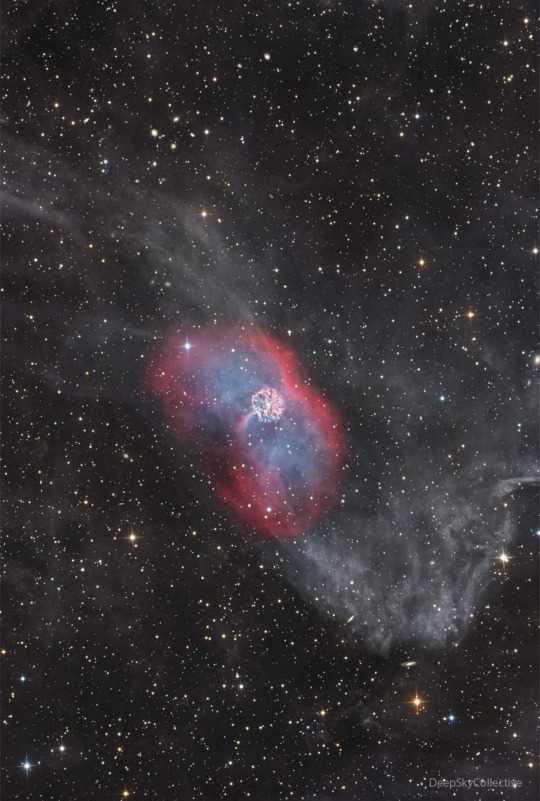
https://apod.nasa.gov/apod/astropix.html
Apod.nasa.gov 04/30/2024
GK Per: Nova and Planetary Nebula
Image credit and copyright: Deep Sky Collective
Explanation: The GK Per star system is known to be associated with only two of the three nebulae depicted. At 1,500 light-years away, Nova Persei 1901 (GK Persei) was the second-closest nova ever recorded. Right in the center is a white dwarf star, the surviving core of an ancient Sun-like star. It is surrounded by the circular Fireworks Nebula, gas that was ejected by a thermonuclear explosion on the surface of the white dwarf -- a nova -- such as recorded in 1901. The bright red gas surrounding the Fireworks Nebula is the atmosphere that used to surround the central star. This gas was expelled before the nova and appears as a diffuse planetary nebula. The tenuous gray gas passing through is an interstellar cirrus that appears to be just coincidentally passing through. In 1901, GK Per's nova became brighter than Betelgeuse. Similarly, the T CrB star system is expected to erupt in a nova later this year, but we don't know exactly when or how bright it will become.
0 notes
Text
Nova explosion 2024 date approaches. Better than the eclipse? [ Star ]
Nova explosion 2024 date approaches. Better than the eclipse? [Highlights]
Need your next celestial fix? A recurrent nova called T Coronae Borealis,
or T CrB, will soon be visible from Earth to the naked eye.
Astronomers are predicting a once-in-a-lifetime stargazing opportunity
could appear in the northern hemisphere sometime in 2024—a “new” star…
UNDATED (WKRC) – As if the recent total solar…
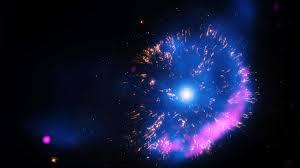
View On WordPress
0 notes
Text
Yakında gökyüzünde yeni bir Kutup Yıldızı görünecek

Gökbilimciler, nadir görülen bir kozmik olgunun yaklaştığını bildiriyorlar .Parlaklık açısından Polaris'ten(Kutup Yıldızından) daha düşük olmayan yıldız T Coronae Borealis (T CrB), yakında gece gökyüzünde görünecek. Gözlemciler, herhangi bir optik cihaz kullanmadan Corona Borealis takımyıldızındaki parlaklığını görebilecekler. Bu olayı kaçırmamaya çalışmalısınız çünkü bir sonraki döngü ancak 80 yıl sonra gerçekleşecek.
T Coronae Borealis artık güçlü dürbünlerle gözlemlenebiliyor. Döngüler 80 yıllık bir süre boyunca düzenli olarak ortaya çıkıyor; kayıtlı tarihte zaten iki kez gözlemlendiler. Bu tür son döngü 1946'da meydana geldi. Birkaç gün sürecek bir sonraki parlaklık patlamasının bu yılın Mart ayından Eylül ayına kadar gerçekleşmesi bekleniyor.
Gerçek şu ki T CrB ikili bir yıldız sistemidir. Onu oluşturan yıldızlar yakın bir yörüngede dönerler; cüce yıldız, kırmızı dev tarafından aktif olarak salınan gazı emer. Bu, güçlü bir termonükleer patlama için yeterli miktarda gaz birikene kadar devam eder. 80 yıl aralıklarla meydana gelen bu patlamalar, karadaki yıldız gözlemcileri tarafından parlak bir şimşek şeklinde gözlemlenmektedir .
Read the full article
0 notes
Text
This rare space phenomenon occurs when a white dwarf star and red giant are close together. As the red giant sheds its outer layers, the white dwarf absorbs that matter on its surface until it eventually overheats, triggering a thermonuclear reaction, also known as a nova outburst, according to NASA.
It's expected to shine as bright as the North Star, Polaris, when it explodes some time between now and September 2024, according to NASA. Once its brightness peaks, it will be visible to the naked eye for several days before it dims again.
"The star system, normally magnitude +10, which is far too dim to see with the unaided eye, will jump to magnitude +2 during the event," NASA said in a news release.
The star system at the center of this event is called T Coronae Borealis, or T CrB, and sits in the constellation Corona Borealis. When the outburst occurs, it will appear as a "new" bright star in the North Crown, which is a small arc between the constellations Bootes and Hercules.
1 note
·
View note
Link
Nova adında olan ender bir kozmik patlamada seyirciler, Samanyolu'nda yeni bir yıldızın doğuşunu seyretmek için hayatlarında bir kez karşılaşabilecekleri bir fırsat yakalayacak. NBC Haberleri bildirdi. Bu ender "nova patlaması" kabaca her 80 yılda bir meydana geliyor ve son olarak 1946'da görüldü.Patlama, Dünya'dan 3.000 ışıkyılı uzaklıkta bulunan T CrB olarak da malum T Coronae Borealis sisteminde meydana gelecek.T Coronae Borealis sistemi ölmekte olan bir yıldızdan (kırmızı dev) ve ölmekte olan yıldızdan madde çalan daha minik bir beyaz cüce yıldızdan oluşur. İki yıldız birbirine o denli yakın ki, kırmızı yıldızdan salınan hidrojen devamlı olarak beyaz cüceye akıyor, tazyik ve ısı oluşturuyor ve sonuçta bir patlamayı tetikliyor. Louisiana Eyalet Üniversitesi'nden emekli fizik ve astronomi profesörü Bradley Schaefer'e gore, zirve noktasında, "Sema parlak olacak, dolayısıyla arka bahçenizden kolayca görülebilecek."Gökbilimciler, nova patlamasının bugünden eylül ayına kadar herhangi bir zamanda gerçekleşebileceğini ve o denli parlak olacağını, çıplak gözle görülebileceğini ve muhtemelen birkaç gün kalacağını tahmin ediyor. Nova, birkaç gün içinde kaybolan parlak "yeni bir yıldızın" ortaya çıkmasına yol açan astronomik bir vakadır.
0 notes
Text
Estrella va explotar y será visible a simple vista
Se prevé que un sistema estelar, situado a 3.000 años luz de la Tierra, pronto será visible a simple vista.
Se prevé que un sistema estelar, situado a 3.000 años luz de la Tierra, pronto será visible a simple vista. Esta podría ser una oportunidad de observación única en la vida, ya que el estallido de una nova sólo ocurre aproximadamente cada 80 años. T Coronae Borealis, o T CrB, explotó por última vez en 1946 y los astrónomos creen que volverá a hacerlo entre febrero y septiembre de 2024.
Una…

View On WordPress
0 notes
Text
Una nova nel cielo notturno creerà "una nuova stella": come vederla.
Una Nuova Stella nel Cielo Notturno: T Coronae Borealis Nelle prossime settimane potresti assistere a qualcosa di straordinario nel cielo notturno: T Coronae Borealis, nota come T CrB, una nova che brillerà intensamente per una settimana prima di svanire. Questa nova è un’esplosione nucleare che si origina da una stella morta da tempo, a circa 3.000 anni luce da noi. Non è un evento apocalittico ma uno spettacolo affascinante per gli appassionati di astronomia. Bradley Schaefer, astrofisico della Louisiana State University, descrive l’evento come “un cataclisma imminente divertente ed emozionante” per gli osservatori terrestri. Cos’è una Nova? Le novae sono
0 notes
Text
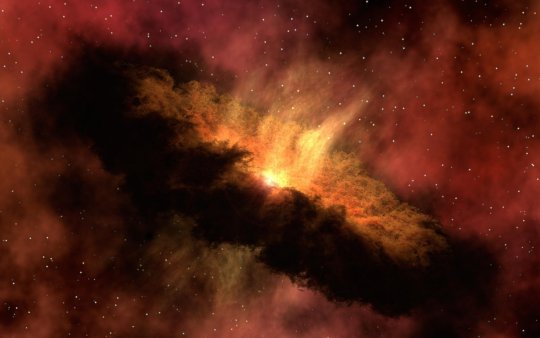
Astrophysicist explains science behind once-in-a-lifetime nova outburst that will light up the sky this year
The total solar eclipse isn't the only reason to keep your eyes to the sky this year. For the first time in 80 years, a star system 3,000 light years away will be visible to the naked eye thanks to a once-in-a-lifetime nova outburst.
NASA announced that the nova, which will create a "new" star in the night sky, will light up the night sky some time between now and September and be as bright as the North Star. One of only five recurring novae in our galaxy, it will be visible for a week before it fades back down.
Jonathan Blazek, an assistant professor of physics at Northeastern University, says this is an exciting moment for amateur astronomers and astrophysicists alike. It's not technically a new star, just a star that is now bright enough for people to see more clearly, Blazek says, but it provides an opportunity to see and understand the cosmos in a new way.
What exactly is a nova?
"There's a broad class of these sorts of events, and they typically share the trait of having two objects, or sometimes more than two objects, close to each other, and you're transferring mass from one to the other," Blazek says. "Eventually, you build up enough mass on usually the hotter object that it ignites, in this case undergoing fusion, and then suddenly you get a very rapid release of energy so it gets much, much brighter."
The star system in question is T Coronae Borealis, or T CrB, and it contains a white dwarf and red giant, two stars that create the perfect conditions for a nova outburst.
A red giant is what happens when a star, like our sun, runs out of fuel and becomes larger and cooler, turning red instead of the white or yellow of a hot star. A white dwarf is what a red giant turns into when it runs out of even more fuel: a very compact star.
What happens when these two stars co-orbit one another is that the white dwarf steadily strips away the atmosphere of the expanding red giant.
"The white dwarf is much smaller and much more compact, so you build up a little disk of mostly hydrogen and maybe some helium as well sitting on the white dwarf," Blazek says. "Eventually enough of it builds up and basically ignites. It's not literally burning in the sense of fire; it's thermonuclear burn and you have hydrogen undergoing a fusion reaction."
As it undergoes that runaway thermonuclear reaction, the white dwarf gets hotter, bigger and brighter, making it easier for us to see it back on Earth. This entire process is part of the natural lifecycle of these stars and why they happen every 80 years. After a white dwarf like this goes nova, it goes back to stripping gas away from the red giant, building up gas at the same rate before eventually another outburst occurs.
Outside of the novelty of these novae,, Blazek says systems like T CrB are particularly interesting for astrophysicists because they are prime candidates for Type 1a supernovae, even larger stellar explosions that are integral to mapping the cosmos.
When a star like T CrB's white dwarf hits a certain mass after repeated novae and it can't support its own mass, it starts to collapse and erupts into a massive, bright explosion, known as a supernova. Novae occur every 80 years, but supernovae are one-time events because they are so powerful that they end up destroying a star. Type 1a supernovae are even more notable because they seem to always have the same brightness, which means they likely always happen to stars of the same mass, Blazek says.
"These are cosmologically super interesting because you can see them really, really far away, and because they're almost always the same brightness, you can use them as very particular probes of the universe," Blazek says. "You can basically map out how bright something is at different distances away and use that to say, "How is the universe changing at different distances?" This is actually how they discovered dark energy."
This is why organizations like NASA and astrophysicists across the globe will likely be pointing countless telescopes at the sky to monitor this nova, Blazek says.
"We're at the stage where we have discovered dark energy using the supernova, but if we want to go to the next level of precision, we need to do a better job of really understanding deep down what these things are, how much variance there is between different objects and things like that," Blazek says.
As for the rest of us, looking up into the night sky and seeing a new source of light in the night sky will be enough. Luckily, it's so bright that this might be one of the few times where city dwellers might have an advantage when it comes to stargazing.
"Obviously, you'll get a better view if you go somewhere dark, but if you go somewhere dark, you'll see a lot of stuff up there," Blazek says. "If you want to have an easier time finding it, stay somewhere bright and then you can only see the really bright stuff, so it'll pop out behind the Boston glow."
5 notes
·
View notes